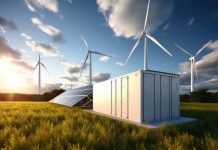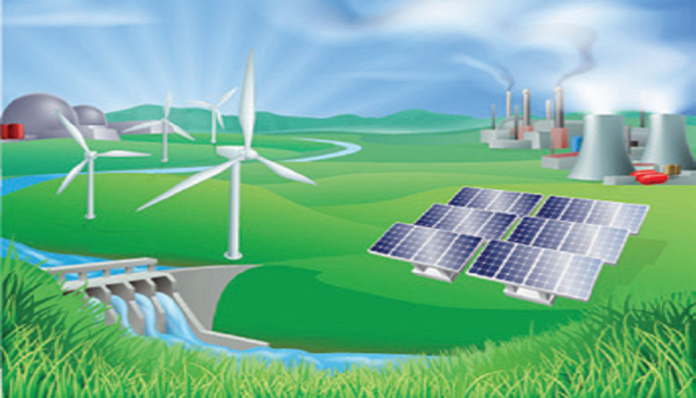Abstract
If India has to reach net-zero emissions by 2070 – and if this is possible at all – considering the huge increased energy demand in the country by then, by shifting from fossil fuels to renewables, then the country has to exploit all possible non-fossil energy sources. It also needs to shift to highly energy efficient processes and systems in all our activities. The Government of India is expected to come up with an energy transition plan soon.
This article comprehensively covers the entire spectrum of energy use and choices before the country, juxtaposing the transitional options with renewables and the huge challenges involved.
Introduction
As Indian economy is targeting to grow to $5-trillion by 2025 and towards $10-trillion by 2030, steady increase in energy demand will take shape.
Government of India wants to draw up an energy transition roadmap for the oil and gas sector, that could prove to be a key step on India’s path to reach net-zero emissions by 2070.
Government of India has set up Energy Transition Advisory Committee, which has been asked to prepare plans for alternatives to hydrocarbons. The committee has until the middle of 2022 to recommend a roadmap for the energy transition.
There are a few alternate strategies that the government is trying to implement and such strategies need to be examined dispassionately and without an element of wishful hope.
Objective of Energy Transition Road Map
- To avoid or significantly reduce the use and import of crude oil, natural gas and coal.
- To achieve zero emission by 2070.
The Road Blocks
Excessive import dependence on crude oil and natural gas
India presently imports more than 230 million tonne of crude oil every year. Imports cover about 85 percent of India’s overall crude oil needs. More than 50% of natural gas requirements are met by import.
It appears that it is unlikely that the domestic production of crude oil and natural gas would be increased significantly in the foreseeable future.
On the other hand, it would take big efforts even to maintain the production of crude oil and natural gas at the present level, since the oil and gas wells are known to have short life and new discoveries are not happening adequately.
Actually, several gas exploration efforts in India have been blocked due to the protests from activists.
The above conditions imply that India would continue to depend upon the large scale of import of crude oil and natural gas for very long time to come, particularly since the increase in demand/import could be 6 to 7% per annum.
The increasing outflow of foreign exchange due to the import of crude oil and natural gas would be a matter of high concern.
World Oil Outlook 2021, flagship publication by Organisation of Petroleum Exporting Countries (OPEC), has projected that the crude oil demand in India is expected to reach around 11 million barrels per day by 2045, as compared to 4.9 million barrels per day in 2021.
As a matter of fact, in Parliament, the Petroleum Minister has clearly said that oil and gas would continue to meet the ‘baseload’ energy demand of India in “foreseeable future”
Continued focus on Coal Production
India is the large producer, consumer and importer of coal in the world. In India, coal fired power plants account for the majority of electricity generation. The projected requirement is 727 million tonne of coal for coal based power generation for 2022-23.
Despite efforts to diversify to the alternatives, such as renewable energies, coal would remain India’s major source of electricity.
Coal India, which produces 670 to 700 million tonne of coal per annum (around 80 percent of India’s coal requirement), aims to ramp up output to one billion tonne by 2024.
Obviously, there is no plan to do away with the use of coal at any time in future.
Methane emission in India
There is large amount of methane gas production / emission from livestock population in India. There is no way of collecting the methane gas from millions of cows and buffaloes in the country.
Methane emission also takes place from usage of natural gas as feedstock / fuel and during storage and transportation of natural gas.
The share of natural gas in India’s primary energy mix has risen to 6.7 percent last year from 6.3 percent previously. The government’s target is to raise the share of natural gas in energy mix to 15 percent by 2030.
India is now committing itself firmly to import natural gas for long time to come and several LNG terminals for import of natural gas are in operation and under construction.
Though it is interpreted that natural gas is “eco friendly feedstock / fuel”, this is not really so, since millions of tonne of methane emission from natural gas take place all over the world and in India also.
How can zero emission target be met without zero use of crude oil, coal and natural gas?
India has set a goal to achieve net zero carbon emissions by 2070.
If India were to have oil, natural gas and coal to meet the base load energy demand in foreseeable future, the vexed question is how can India achieve zero emission target in future? Even by the year 2070.
The Options
The options available for the government to implement a road map for energy transition are challenging.
Such options presently being planned/implemented include the following:
- Massive production of electric vehicles
- Blending of ethanol with petrol
- Focus on increase in generation of renewable power
- Greater focus on hydrogen generation and utilisation
- Investment in nuclear power projects
- Creation of energy storage facilities
Electric Vehicles Scenario
The International Energy Agency’s outlook for India, published recently, said that India’s current policies would see a huge expansion in the transport sector. An extra 25 million trucks are expected on the road by 2040 and more than 300 million vehicles will be added to India’s fleet by that time.
Government’s hope
By promoting the shift from internal combustion engine (ICE) vehicles to Electric Vehicle (EVs), Govt. of India not only hopes to significantly cut emissions and meet its international obligations but also reduce fuel import and improve the nation’s energy security.
Minister for transport has claimed that if electric vehicles were to expand to 40% in the two-wheeler and car segments and close to 100% for buses, India would be able to cut crude oil consumption by 156 million tonne per year, worth Rs.3.5 lakh crore. This could be considered as hypothetical statement, more based on hope than on ground realities.
There are around 9 lakh electric vehicles on Indian roads now.
In India with the third largest road network in the world, the total number of vehicles in fiscal year 2019 stood at 295.8 million. Share of electric vehicle in total number of vehicles will not be large in the foreseeable future.
Government’s target
Government wants to have EV sales accounting for 30% of private cars, 70% for commercial vehicles and 80% for two- and three-wheelers by 2030.
The government has announced some much-needed support measures to promote EVs., which include setting up of 2877 EV charging stations, battery swapping policy etc.
Matter of concern
One matter of concern about EV vehicles sector in India is that lithium ion battery cell is not produced in India, which is an essential component of electric vehicle. Further, several speciality chemicals /components used in lithium ion battery are not produced in India.
Data from Bloomberg NEF shows that the volume weighted average price of an EV lithium-ion battery (pack & cell) in the global market has come down for $684 per kwh in 2013 to about $132 per kwh as of 2021. Still, batteries and associated components constitute at least one third of the cost of an EV if not more and hence, ability to bring down this cost by any means, will help higher adoption.
It appears that with the rapid growth of EV vehicles, India will become one of the largest importers of lithium ion battery cells in future.
Putting the cart before the horse
Can someone argue that rapid promotion of EV vehicles without setting up facility for large scale of production of lithium ion battery could be similar to the act of putting the cart before the horse?
Petrol/ Diesel Vehicles will have to Continue
Further, the large promotion of EV vehicles will only help in meeting the growth in the future need for transportation to some extent, as increase in demand for transportation would continue at 6 to 7% per annum EVs cannot reduce the present consumption of crude oil and natural gas in India to any reasonable level.
It should be noted that in budget for 2022-23, barely had any mention of traditional (petrol/diesel-run) automotive industry, where demand, particularly in the two-wheeler segment, is at an all time high.
Does this imply that India will never be able to get rid of petrol/diesel driven vehicles in the foreseeable future?
Government Bet on Ethanol Blended Petrol
The government’s roadmap proposes a gradual rollout of ethanol-blended fuel to achieve E10 fuel supply by April 2022 and phased rollout of E20 from April 2023 to April 2025. Currently, 8.5 percent of ethanol is blended with petrol in India.
It is estimated that successful adoption of the E20 programme can save Rs. 30,000 crore per annum on oil imports.
Promotional efforts
The government has lowered Goods and Services Tax rate to 5 percent from 18 percent on ethanol meant for blending to promote the ethanol blending programme.
Government has approved 368 projects for setting up of new distilleries /expansion of existing distilleries, based on sugarcane juice, B heavy and C heavy molasses, maize, damaged food grains and rice.
It is likely that India will be able to achieve 20% ethanol blending with petrol, at least by 2030 if not earlier.
However this is unlikely to reduce the present level of use of petrol significantly, since the demand for petrol would steadily increase year after year at 6 to 7% per annum.
Petrol consumption will continue to increase
Considering 80% capacity utilisation, the production of ethanol by 2025 could be around 1200 crore litre, if total capacity of 1500 crore litre were to be built up by 2025.
Possible supply shortage of ethanol
With the production of 1200 crore litre by 2025, and if 1016 crore litre were to be used for blending with petrol (20% blend), then the country would face severe supply shortage of ethanol for other purposes including human consumption.
Stress On Renewable Energy
Govt. of India has expressed determination to promote renewable power to curb carbon emissions and promote energy security.
Existing capacity level of solar power is 49.35 GW. Wind power capacity is at around 40 GW and biomass power capacity is at around 10 GW. Small hydro segment account for around 5 GW
Now, Government has raised the capacity target for renewable power to 500 GW by 2030, which is a very ambitious target.
Government is focussing largely on significantly increasing the capacity of solar power. However, India has “limited operational annual capacities” of around 2.5 GW for solar PV cells and 9 to 10 GW of solar modules. Clearly solar module capacity needs to be ramped up to meet the solar power target.
Import dependence
India has evolved in assembling modules, but it is in processing and producing silicon wafers that capacity is wanting.
Over two third of the solar cells requirements are presently imported from China, which, remains an area of concern.
Seasonal power
To increase the domestic production, Government has topped its five-year production-linked incentive scheme for making solar modules by a generous Rs. 19,500 crore grant.
However, it need to be kept in view that renewable power generation depend on seasonal factor.
Further, the capacity utilisation of renewable power sector such as solar and wind are only around 20%, as against around 60% for fossil fuel based thermal power plant.
Renewable power will not be adequate
While renewable power is an elegant way of eco friendly power generation, considering it’s low capacity utilisation and seasonal nature of output, it is unlikely that renewable power can significantly reduce the requirement of fossil fuel for power generation in the coming years.
This would particularly be so, since the requirement of power in India would steadily increase in tune with the overall economic and industrial growth in the country at 6 to 7% per annum.
Hope On Hydrogen
Hydrogen energy has huge development space from transportation to power generation to home application.
A complete hydrogen energy industrial chain, integrating manufacturing, R&D, storage, transportation, application and consumption is sought to be developed in several countries.
Just like several other countries, India is also hoping that hydrogen energy would enable India to relieve it from the dependence on fossil fuel and also help in achieving the reduction in the emission. India through its National Hydrogen Mission, have announced specific policy interventions to push for the widespread adoption of green hydrogen.
Hydrogen must be separated from other substances like water or fossil fuels. For example, industries like oil refining use large quantities of so-called grey hydrogen that is mostly made by separating hydrogen from natural gas. And that process generates greenhouse-gas emissions. In fact, less than 5 percent of the hydrogen produced today is emission-free.
Water electrolysis process
The issue with regard to green hydrogen by water electrolysis process is due to the fact that the production process is power intensive. Every kilogramme of green hydrogen production requires 48 kWh of power.
The production of massive quantity of green hydrogen to the required level in India would demand huge quantity of power requirement.
If such power requirement were to be met by renewable energy source, it would be a welcome proposition. However, this is unlikely to happen due to the low capacity utilisation and fluctuating renewable power generation due to seasonal factors and the fact that India would not have adequate renewable energy capacity to meet the large requirement of green hydrogen projects in a massive scale.
It would be counter productive to produce green hydrogen by water electrolysis, using thermal power generated by burning fossil fuel.
Another major challenge is cost of production of green hydrogen.
To bring down costs, the cost of the electrolyser which splits water has to be reduced. Possibly, scale of green hydrogen plant capacity can bring down the cost to some extent. Another challenge is the efficiency of the electrolysers–basically, how much electricity it consumes to produce a kg of hydrogen.
Government of India is taking proactive steps with plans to set up 5 GW of electolyser for green hydrogen production, in the first phase of the green hydrogen projects.
How much green hydrogen India needs?
The current consumption of hydrogen in India is about 5.6 million tonnes, but almost all of it comes from the ‘steam methane reforming’ process, which emits the greenhouse gas carbon dioxide.
So, today, if the country were to replace all the hydrogen in use with green hydrogen, the demand for green hydrogen would be around 5.6 million tonne per annum.
To produce this much, electrolyser capacity of more than 110 GW is required. Roughly, the production of one tonne per annum of green hydrogen requires 18 GW of electrolyser capacity, which in turn require 26 GW of solar power.
It is unrealistic to think that all the hydrogen in demand could be switched over to eco friendly green hydrogen.
There are several research initiatives under way around the world to produce green hydrogen with lesser cost of production and greater efficiency. But, all such efforts are still in the study stage and it is too early to predict about the commercial success and if so when.
Meanwhile, several announcements about green hydrogen projects have been made in India which make pleasant reading, even if they may be wishful thinking at the present stage due to various uncertainties.
Government of India need to be much more realistic in working out it’s targets for production of green hydrogen.
Innovative project using renewable energy and green hydrogen
A few innovative projects are coming up where renewable energy, green hydrogen and microgrids converge to complement each other.
NTPC Ltd is setting up one floating solar renewable energy powered fuel cell based 50 kW microgrid as a pilot at its 2,000 MW Simhadri thermal power plant near Visakhapatnam.
At Simhadri, NTPC has already set up a 25 MW floating solar project, and with the expertise of Bloom Energy, it is now developing a standalone fuel cell based microgrid with hydrogen production.
Hydrogen will be produced by the advanced 240 kW solid oxide electrolyser using the power generated by the floating solar project during the day. The hydrogen is then stored at high pressure for use by a 50kW solid oxide fuel cell.
The system would work in a standalone mode from 5 pm to 7 am. The project’s configuration has been designed in-house. The company currently has an installed capacity of over 67,907.5 MW.
This will be India’s first green hydrogen-based energy storage project and one of the world’s largest. It could be a precursor to large-scale hydrogen energy storage projects, and useful for studying and deploying multiple microgrids in various off- grid and strategic locations of the country.
Nuclear Power
India has at present 23 reactors with total capacity of 7,480 MW, including the 700 MW KAPP-3 that was linked to the grid in January 2021.
In addition, there is a plan to build a fleet of ten units of 700 MW of Pressurized Heavy Water Reactors), which would add another 7,000 MW. And then, 8,000 MW of nuclear power plants are at various stages of construction, including the four Kudankulam units and the 500 MW Prototype Fast Breeder Reactor.
The government expects the country to have 22,480 MW of nuclear power by 2031. Nuclear power projects is an excellent initiative as nuclear power is eco friendly and can operate at 100% capacity utilisation, unlike renewable energy projects.
However, considering the level of investments involved and protest against nuclear projects by vested interests, it is doubtful whether India would be able to step up nuclear power capacity to very high level.
It may be noted that in France, around 70% of the power requirement is met by nuclear power projects. Can this happen in India?
Energy Storage System
Energy storage system technology, including battery energy storage systems (BESS), pumped hydro energy storage (PHEs) or other technologies will be essential in order to integrate and store large volumes of renewable energy.
India aims to have 500 GW renewable power by 2030.
By 2030, India would need 38 GW four hour battery storage and 9 GW of thermal power balancing power projects as well as cost efficient and reliable integration of renewables.
India currently has just 20 MW of installed battery storage capacity with 1.7 GW of battery capacity in the pipeline.
To enhance domestic manufacturing of advanced chemical cell (ACC) battery storage, the Department of Heavy Industry, Government of India issued a notification for the performance linked incentive programme (PLI) National Programme on Advanced Chemical Cell (ACC) battery storage.
While significant efforts are being put forth, India has to go a long way to build up required level of energy storage capacity.
Other Options that should be Considered
There are other attractive options for renewable power generation based on algae crop and jatropha crop.
Unfortunately, today little attention is being paid to such feasible opportunities.
Algae biofuel
Algae crop takes sunlight and carbon dioxide as building blocks and makes long chains of oil that can be converted to biodiesel.
Algae can be cultivated in saline/brackish water/coastal seawater on non arable land and do not compete for resources with conventional agriculture.
 Algae synthesize and accumulate large quantity of oil [20–50% dry cell weight (DCW)] and algae crop grows at high rates (e.g. 1 to 3 doublings per day).
Algae synthesize and accumulate large quantity of oil [20–50% dry cell weight (DCW)] and algae crop grows at high rates (e.g. 1 to 3 doublings per day).
Opportunities for India
The scope for investing in algae project is promising because algae can produce between 7,500 and 19,000 litres of fuel per acre, far more than any other renewable feedstock.
Additional economic value is possible through production of high value co-products during the production of biofuel that include ethanol, methane, hydrogen, nutraceuticals, animal feed and biofertilizers.
The use of algae biofuel would help drastically reduce GHG emissions from medium and heavy duty trucks, aircraft and ships.
The European Union Renewable Energy Directive, which sets targets for the proportion of renewables required to contribute to the energy market, is being amended to value the contribution of algae biofuels as four times their energy content.
This means that suppliers of biodiesel produced from algae will receive four times the amount of government support compared with growers of land-based oil crops.
A number of algae biofuel projects are successfully operating in developed countries.
Strategies
There is no doubt that algae projects provide excellent investment opportunities in Indian conditions, that should not be ignored and it has to be utilized in optimum manner.
Project capacity
Considering the availability of waste land / marshy land in India, it is feasible to set up algae farm of atleast one million acre in different parts of the country in the next few years.
Obviously, such algae farm has to be located in waste land in various location.
It would be appropriate to have individual algae farm of 1000 acre in each location. Unfortunately, India has not paid enough attention so far, to exploit the biofuel opportunity that algae industry can provide.
Several experts think that massive cultivation of algae in the country and production of biofuel from algae can relieve India from energy crisis situation to a considerable extent.
Jatropha Biofuel
When Atal Behari Vajpayee was the Prime Minister of India, there was huge claim that production of jatropha biofuel would be the ideal strategy to tackle the problem of impending energy crisis and reducing import dependence on fossil fuel.
The virtues of jatropha biofuel were highlighted in several forums and it became the talk of the day.
However, nobody talks about the jatropha biofuel at present and this project is declared to be uneconomic and unfeasible due to various reasons including low yield of oil.
Obviously, adequate research efforts have not been put forth in the country to improve the yield of oil from the jatropha seeds and recovery of oil.
The dream of jatropha biofuel has gone with the wind.
Likely Scenario in the Year 2030
Considering that the target set for year 2030 by Government of India for EVs, blending of ethanol with petrol etc. would be met, the likely scenario in 2030 is assessed as below:
Ethanol blending with petrol
Likely consumption of petrol by 2030 without considering ethanol blending with petrol and considering growth rate demand of 7% per annum – Around 49 million tonne.
Considering 20% ethanol blend with petrol, the requirement of petrol to be made available by utilising fossil fuel in 2030 – Around 39 million tonne.
Renewable energy
- Likely total peak hour demand for power by 2030 – Around 320 GW.
- Considering 500 GW of renewable power capacity by 2030 and considering average capacity utilisation of 20%, the renewable power available by 2030 would be 100 GW.
- Balance peak hour demand to be met by fossil fuel in 2030 : 220 GW.
Electric vehicles
- Number of vehicles on road (all types) by 2030 considering 7% growth rate per annum – Around 580 million
- Considering 0.9 million electric vehicles (all types in 2021 and considering 25 to 30% growth per annum in the production of electric vehicles, the total number of electric vehicles in 2030 – Around 10 million
- Number of vehicles on road excluding electric vehicles in 2030 to be run with fossil fuel would be still very large
Can India Achieve Zero Emission at Any Time?
Government of India is carefully examining the various available options for India to achieve zero emission by 2070, as committed by India during the recent Glasgow Meet.
However, the ground realities indicate that India is unlikely to achieve zero emission even by 2070.
India is a large importer of crude oil and natural gas and demand and import level is likely to increase steadily, as domestic production is likely to remain at near stagnant level.
India is now planning to increase the coal production to one billion tonne per annum. Obviously, crude oil, natural gas and coal would continue to meet the base load energy demand of India in foreseeable future.
Several alternate schemes to reduce the emission levels and reduce dependence on crude oil, coal and natural gas are being implemented such as promotion of electric vehicles, increase in production of renewable energy, development efforts towards hydrogen economy, promotion of nuclear power projects etc.
All such efforts would certainly lead to the replacement of crude oil, natural gas and coal to some extent.
However, demand for energy is likely to increase significantly in the country at 6 to 7% per annum and India would emerge as one of the large consumers of energy in the world in the coming years.
The efforts to promote alternate strategies such as electric vehicles etc. can offset only part of the likely increase in demand for energy, that is now being produced from fossil fuel.
While government of India is thinking forward, viewing the ground realities, one is not sure whether India’s energy transition strategies would be adequate enough to overcome the challenges in achieving zero emission.
































